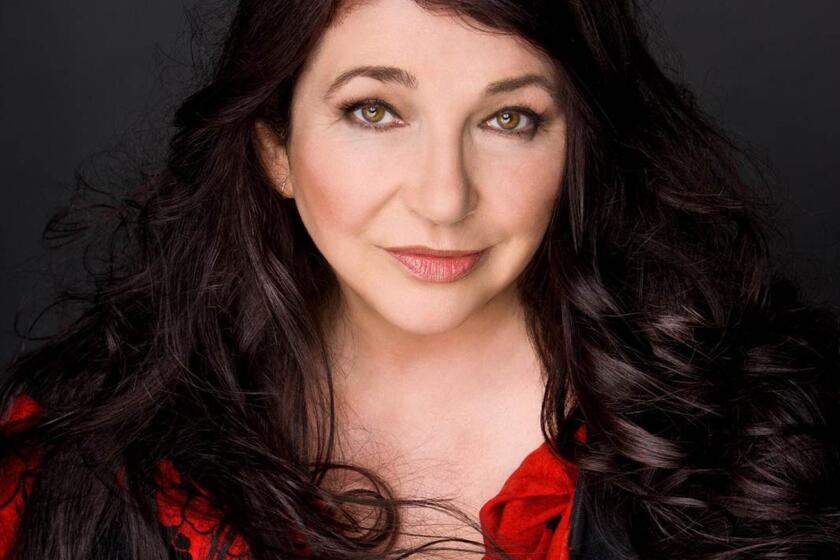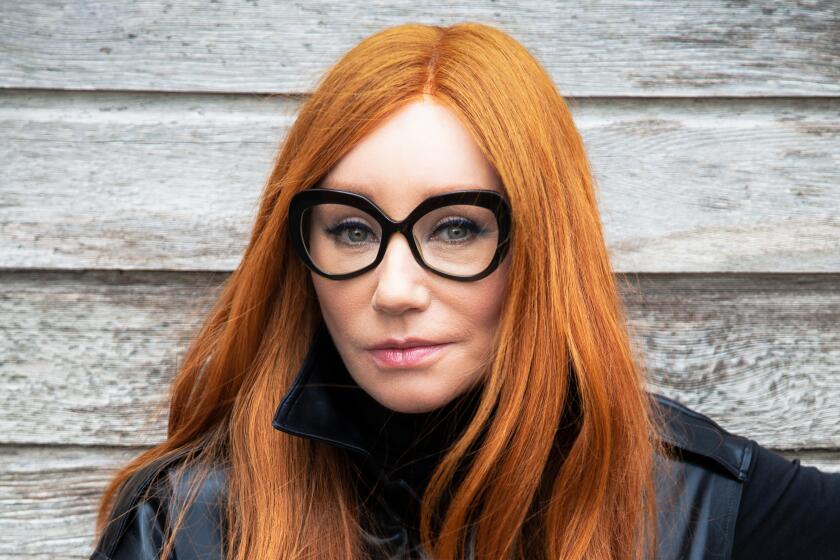Kate Bush always sounded like the future. With a boost from ‘Stranger Things,’ that future is now

- Share via
To the extent that the story of popular music in the past half-century has also been, in considerable part, a story of women gaining evermore control of it, 1985’s “Running Up That Hill (A Deal With God)” was bigger than a hit. It was a landmark and a genesis, an anthemic fount of agency and illumination.
The first song from the fifth studio album by English singer-songwriter Kate Bush, its opening weave of vanguard Fairlight synthesizer and booming Linn drum signified a cloud-parting rupture in her career and in music writ large. It was tacit proof of a woman musician and technician winning by directing it all: Bush was writer, producer, vocalist, keyboardist and arranger. It remains an eternal lighthouse in the night of being other. Bush had already been an unusual star, famous in the U.K. for her sweeping, symphonic piano rock that entwined her interests in glam, folk, new wave, classical and prog. Now she was a groundbreaking if misunderstood multihyphenate whom Spin and NME both proclaimed a genius.
Thanks to its use in the new season of ‘Stranger Things,’ Bush’s 1985 song tops the Spotify U.S. chart. Here’s a deeper dive into her one-of-a-kind discography.
That Bush is having a resurgence and connecting with a whole new generation thanks to “Running Up That Hill‘s” appearance in Season 4 of “Stranger Things” — more than a sync, the song is a recurring plot point in the ‘80s-pastiche series — is cosmically perfect. The theatricality and horror of the show align with Bush’s supernatural inklings. In a time of elevated cultural comprehension of female genius, her place in pop’s pantheon is undeniable: The oddity and mass-appealing melodies of Bush’s vision have cast an outsized influence onto the breed of audacious and unapologetically emotional younger artists who tend to be deified online. And today’s audiences have responded: “Running Up That Hill” is currently No. 2 on Spotify’s Global Top 50 Songs chart, and No. 5 on the Billboard Hot 100.

TV was among Bush’s own formative inspirations. “I was always in front of the television instead of doing my homework,” she once said. “I wasn’t off reading books.” Famously, Bush was watching a BBC adaptation of an Emily Bronte novel one night in 1977 when she proceeded to pen her debut single and what was for 44 years, until last week, her only U.K. No. 1 hit — the first woman-penned-and-performed single to reach that position — “Wuthering Heights.”
Like David Bowie, Bush studied with the illustrious mime artist Lindsay Kemp. Like Prince, with whom she collaborated, she remains legendarily devoted to shape-shifting formal innovation and coining brilliant one-liners like “I want to be a scholar / But I really can’t be bothered!” Having attended Bowie’s Ziggy Stardust Tour in 1973, she became an art-rock spider-from-Mars landed back to Earth by way of the moon whose highwire Baroque voice pulled back time even as her conviction pushed her forward. As if occupying the highest register of an early Joni Mitchell song and pitching her fever-dream soprano from there, defying the presumed heights of a track with the sensitive strength of an acrobat — Mitchell and Billie Holiday are both stated influences — Bush amplified her femininity into the red, vocalizing a graph of her heart.
A precocious and prolific songwriter since childhood, Bush’s homemade tapes landed, in the mid-’70s, into the hands of Pink Floyd guitarist David Gilmour, who was so struck by her talent that he paid for and performed on her first proper demo recordings. Later, while Pink Floyd was finishing 1975’s “Wish You Were Here” at Abbey Road, Gilmour played those demos for the EMI A&R representative who would sign her. Four increasingly experimental albums later, Bush knew her most realized work would require an unprecedented caliber of freedom. The final song of her self-produced 1982 opus “The Dreaming” was called “Get Out of My House” — “My home, my joy, I’m barred and bolted … I won’t let you in”; her desire for more autonomy could not have been clearer. In order to tap deeper into her uncompromised self, she had to locate, in Virginia Woolf’s mold, a studio of one’s own.
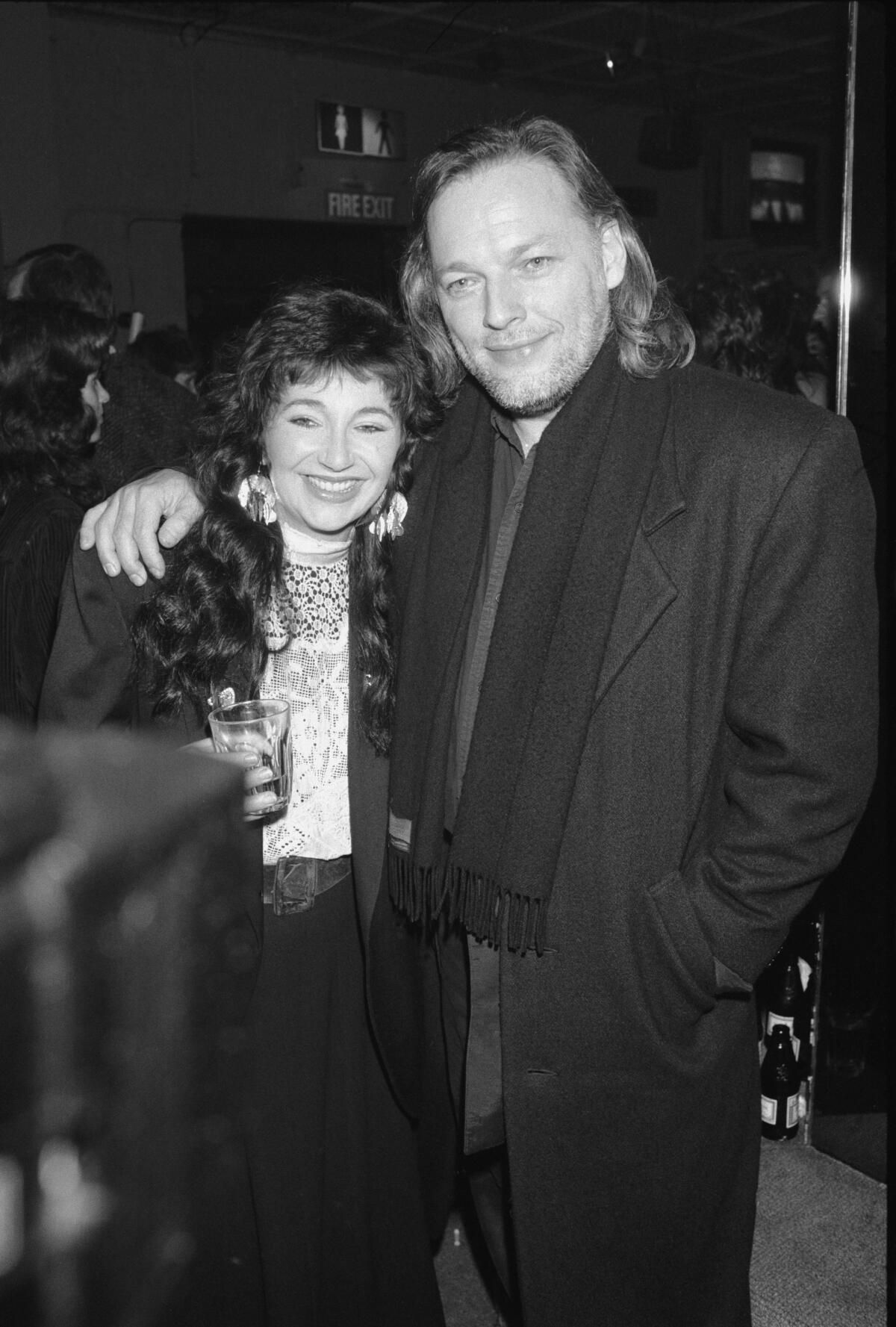
Bush was at a crossroads. “The Dreaming” had not been considered a commercial success; stressed and fatigued by her obsessive work ethic, she said that after the record, “I was just a complete wreck, physically and mentally.” She alleviated her mid-20s burnout by relocating from London back to the Kent countryside of her youth, near the farm where she was raised as the youngest of three in an eccentric, art-loving family. (The 2010 biography “Under the Ivy” describes a 1979 Bush family New Year’s Eve party that was unusually silent: In one room, everyone was stoned; in the other, they were rapt listening to 17th century recorder music.) “The stimulus of the countryside is fantastic,” Bush said at the time. “I sit at my piano and watch skies moving and trees blowing and that’s far more exciting than buildings and roads and millions of people.” She embraced a healthier lifestyle, recommitted to her focused study of dance and, most crucially, built her own 48-track studio in a barn, where she could better access her own intuition, her internal rhythms, working at her own pace to craft her most forthright sound.
Rigorous dance instruction corresponded with Bush’s most ecstatic bursts of creativity. In the period leading to “Hounds of Love,” she was studying with Dyane Gray-Cullert, a dancer from Detroit trained in the expressive Martha Graham technique of modern dance. Emphasizing the severe but highly emotional actions of contraction and release, Graham invented the idea that dance, like poetry, is what you decide it is. For Graham, the practicing dancer became “an athlete of God,” always walking a tightrope. “At times… I fear the venture into the unknown,” Graham once wrote. “But that is part of the act of creating and the act of performing. That is what a dancer does.” This intrepid spirit endowed “Hounds of Love.”
On “Running Up That Hill,” the programmed beat feels irrevocably connected to the bones, as if Bush’s modern dance study is directing the lucid movements of the silvery music — she had also practiced ballet — not the other way around. In the video, Bush extends her hands to the sky. Her voice is exalted by that reach, the rush of stretching one’s limbs, flesh and blood high. “Do you want to know / Know that it doesn’t hurt me?” she sings in her deepest and most incandescent timbre. Bush voices her desire to strike a deal with a higher power in order to switch places with a man, to “exchange the experience” in order to create understanding — in a relationship, maybe in the world still today, where “tell me we both matter, don’t we?” could be a polemical refrain.

This feminist resonance charges every self-produced note of “Running Up That Hill.” Taking on the typically male role of producer, Bush manifests her wish literally. She has said she had to fight to keep producing her own music: “It was felt that my producing ‘Hounds of Love’ wasn’t such a good idea,” she once put it. “For the first time I felt I was actually meeting resistance artistically.” Beneath its thundering drums, a current of uncanny noise runs at the bottom of “Running Up That Hill,” as if to emphasize the undertow of pain that typically propels the process of finding clarity. But in the uphill battle of her anomalous self-sufficiency, Bush did control every component: deciding where to expand or gate a sound, where to add reverb, arranging electronic instruments alongside ancient ones, producing the future.
“If I only could,” Bush sings. For music, it was a self-fulfilling prophecy.
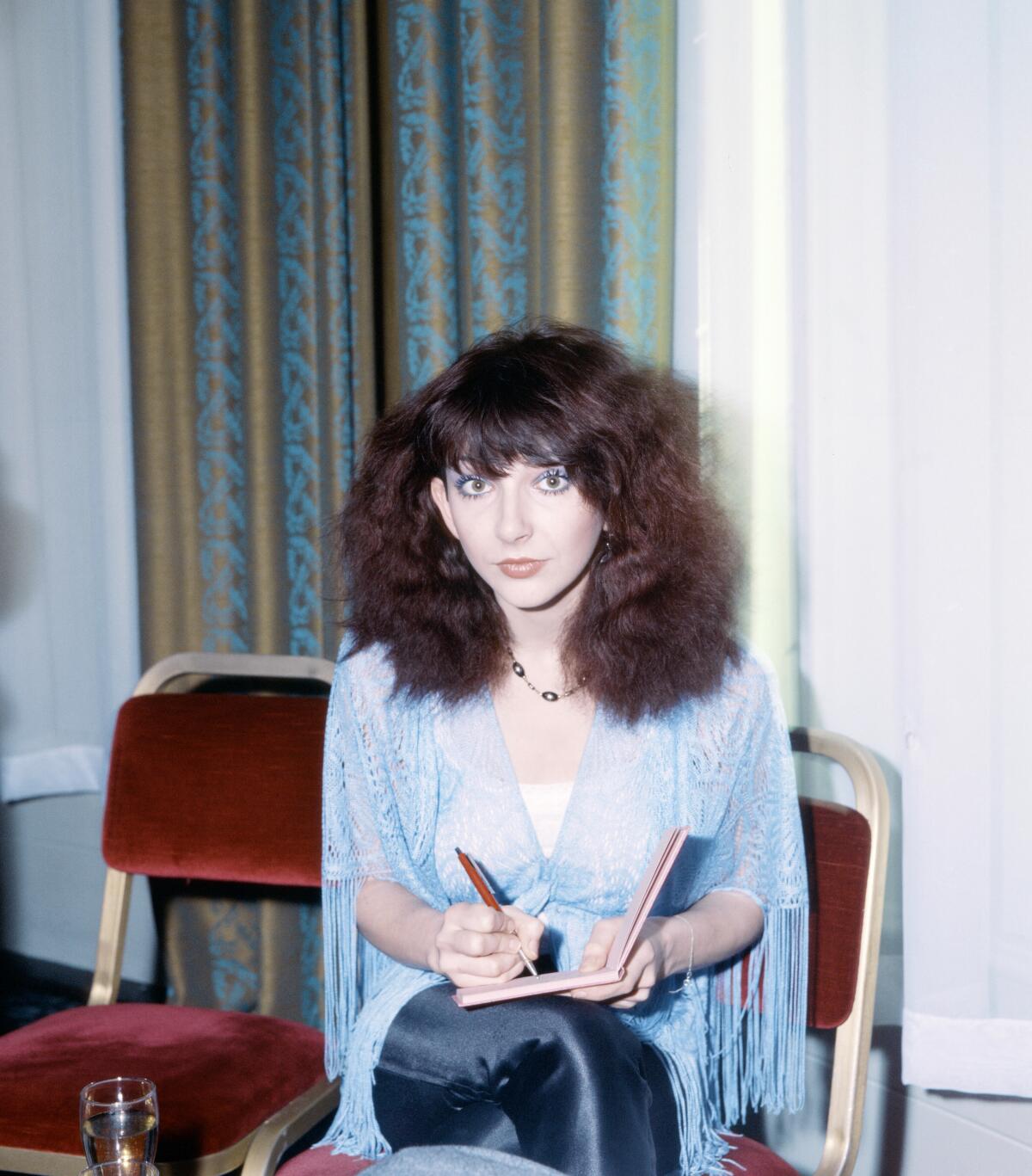
The further up that hill, the closer to the sky. “Hounds of Love” contains explicitly celestial pop music; its Sept. 9, 1985, release party was at the London Planetarium. Maybe that’s why I kept returning to it in the late summer of 2020, when sometimes it felt like the only show left was the sky. Most nights I would run through Brooklyn’s Prospect Park listening to “Hounds of Love,” looking for low-flying bats (Bush has a documented affinity for cute-but-scary flying foxes), staring at the moon, sure that with every mile I was getting closer to comprehending some elemental meaning that might come from, per her suggestion on the title song, taking my shoes off and throwing them in the lake — or at least getting stronger. “Hounds of Love” just makes sense airbound, in motion.
The idea to listen to “Hounds of Love” while running was a suggestion from the young London experimental musician Charlie Valentine, who records as No Home and is one of a patently endless constellation of popular and underground musicians to cite Bush as a North Star. Bush’s high-octane originality prepared the world for such volcanic voices as Tori Amos and Björk, who cites “The Dreaming” as an all-time favorite. Solange has covered her. The Oakland art-pop auteur Tia Cabral, who records as Spellling, recently shared her re-creation of the “Hounds of Love” art. The expressive modern dance and melodrama of Lorde and Mitski, the elegant, subtly ferocious avant-gardism of FKA Twigs, Perfume Genius and Julia Holter — Bush’s influence abounds. Michelle Zauner of Japanese Breakfast said that while making her breakthrough LP, last year’s “Jubilee,” she would ask herself, “What did Kate Bush do?”
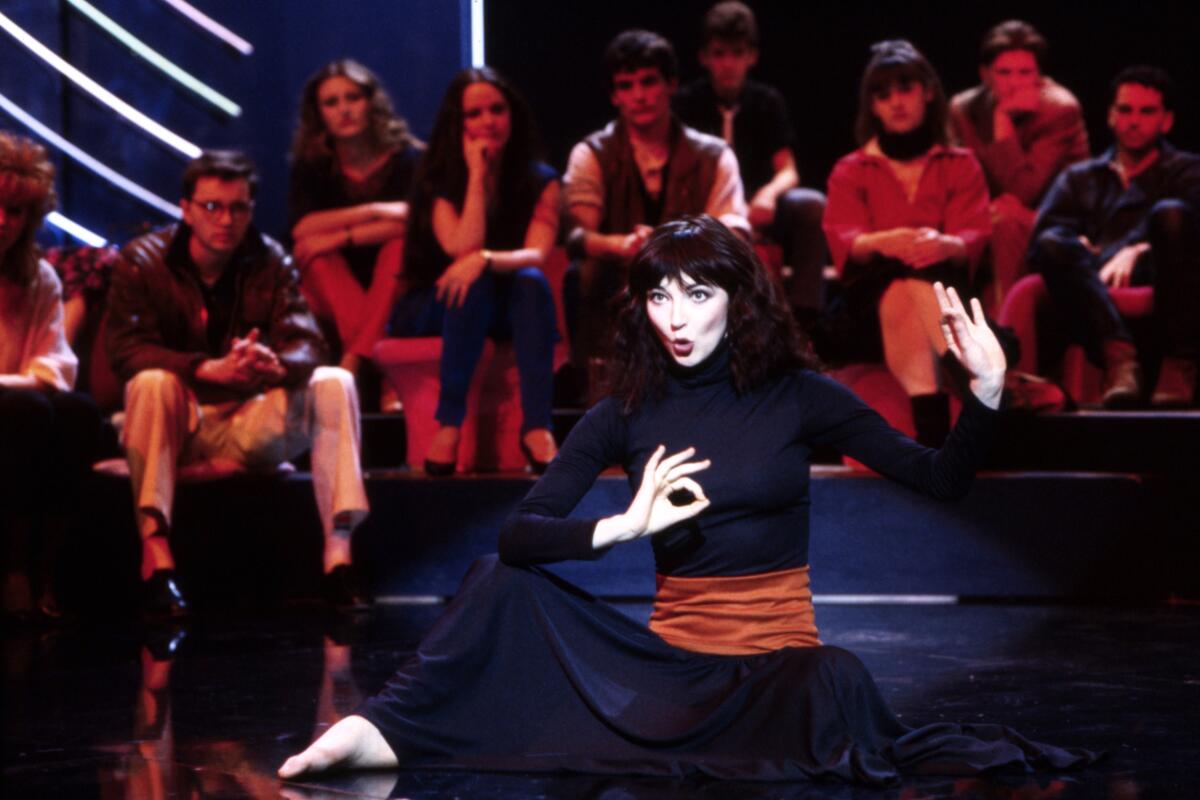
Fiona Apple sang out to Bush in 2020, nodding to “Running Up That Hill” on the title song of her own masterpiece album “Fetch the Bolt Cutters.” Though its sparer instrumentation deviates from the futuristic electronic synthesis of “Running Up That Hill,” it shares in the song’s openness and wonder, in its enlightened feeling of breaking through. “I grew up in the shoes they told me I could fill / Shoes that were not made for running up that hill,” Apple sings, “And I need to run up that / I need to run up that hill / I will, I will, I will,” she incants as the song cracks open to the barks of dogs and personal liberation.
“It was an angry thought: ‘I grew up in the shoes they told me I could fill — not in the shoes I wanted, not the shoes I thought I could fill,” Apple said at the time. As a child, Apple would sit at her piano, singing and playing songs from Bush’s 1978 debut, “The Kick Inside,” out of her sheet music collection “Complete Kate Bush.” Both women entered the pop machine as teenagers, becoming unconventional celebrities; both became staunch defenders of their privacy, rarely if ever touring, seeking attunement to nature. “You can end up playing a role that isn’t you, letting people typecast you in life,” Apple said of that lyric. “But how did I really grow up? And whose footsteps did I want to follow in?” She wanted to run of her own accord. Bush helped guide the way.
After a five-year absence from touring, Tori Amos returns with a new generation of artists in her debt and some thoughts on the power of “the Muses.”
That Apple would reference “Running Up That Hill” on the album where she also took even greater control of her music is fitting. Like Bush, she recorded at home, collaborating with friends and tracking her intuitive rhythms. Like Bush, she sought inspiration from the physicality of Martha Graham, keeping a photograph of the dance icon on her piano. Both “Fetch the Bolt Cutters” and “Hounds of Love” feature dogs in the credits — in the case of Bush, on the cover, her lilac-tinted image surrounded by her family’s two Weimaraners, Bonnie and Clyde — which is surely no coincidence, dogs offering, as they do, the soul-steadying support of love.
“Kate Bush was one of these women who held my hand through my life,” Apple said. “It felt good to reach out a little bit and say: I’m following her up the hill.” Thirty-seven years on, Bush’s ascendant path keeps inviting the possibility.
More to Read
The biggest entertainment stories
Get our big stories about Hollywood, film, television, music, arts, culture and more right in your inbox as soon as they publish.
You may occasionally receive promotional content from the Los Angeles Times.
